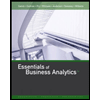
1
Per unit cost in traditional costing method
Under traditional costing method, per unit cost is calculated by adding per unit cost of direct material, labor and
Unit product cost for both the products under traditional costing method.
2
Per unit cost in Activity based costing:
Under activity-based costing, per unit cost is calculated by adding per unit cost of direct material, direct labor and overheads. Here, different activities are identified that give rise to indirect cost and total cost of all the activities (total indirect cost) are allocated to products in the ratio in which products use or consume different activities.
To calculate: Per unit cost under activity-based costing method.
3
Traditional costing and activity-based costing Both the methods are used in cost accounting to allocate the overheads or indirect cost and to calculate total costs. Traditional costing system uses only one base for such allocation and activity-based costing system uses more than one base based on different activities.
To explain: Which costing system provides more accurate costs.
Want to see the full answer?
Check out a sample textbook solution
Chapter 4 Solutions
INTRO MGRL ACCT LL W CONNECT
- There are different tools for analyzing the financial statements of a company, such as horizontal analysis, vertical analysis, ratios for measuring financial health and profitability, and so forth. Why do we need different tools for analyzing financial statements? Don't the numbers in the financial statements speak for themselves?arrow_forwardPlease help me solve this financial accounting question using the right financial principles.arrow_forwardSales made in fiscal 2025 for $50,000,000 include a 5-year warranty coverage. The estimated cost for warranty is expected to be 2% for each of the first 4 years and 5% for the last year. Determine how much warranty expense will be recorded in fiscal 2025. Question 2 options: $6,500,000 $4,000,000 $1,000,000 $5,000,000arrow_forward
- Agree or disagree with the post Financial statements provide raw data, but without analysis, they lack meaningful insight. Different tools help uncover trends, assess financial health, and compare performance effectively. Horizontal analysis tracks changes over time, identifying growth patterns or declines. Vertical analysis expresses financial items as percentages of a base figure, making comparisons across companies easier. Like liquidity, profitability, and solvency measures, ratios offer critical efficiency, risk, and stability assessments. These tools translate numbers into actionable intelligence, helping businesses, investors, and analysts spot risks, make informed decisions, and drive strategic planning. Without them, financial statements can be overwhelming and lack clarity. Agree or disagree with the postarrow_forwardWhat was the gain or loss on the disposal?arrow_forwardCompute the gain or loss on the transfer of equipment.arrow_forward
- What is the cost of unused capacity?arrow_forwardA $100,000 5-year 6% bond is issued on January 1, 2026. The bond pays interest annually. The market rate is 7%. What is the selling price of the bonds, rounded to the nearest dollar? Question 6 options: $104,213 $95,900 $100,000 $4,100arrow_forwardA $100,000 5-year 6% bond is issued on January 1, 2026. The bond pays interest annually. The market rate is 7%. What is the selling price of the bonds, rounded to the nearest dollar? Question 6 options: $104,213 $95,900 $100,000 $4,100arrow_forward
- Dell Industries has a normal capacity of 30,000 direct labor hours. The company's variable costs are $45,000, and its fixed costs are $27,000 when operating at normal capacity. What is its standard manufacturing overhead rate per unit?arrow_forwardWhich statement about a "treasury shares" is correct? Question 10 options: These shares continue to have voting rights. These shares must be cancelled upon re-purchase. The company does not pay dividends on these shares. These shares are disclosed as issued and outstanding.arrow_forwardWhich statement best describes the accounting when a company cancels its own shares at an amount higher than the average share value? Question 9 options: Contributed surplus and retained earnings will be debited. Contributed surplus will be debited, thereby decreasing equity. Contributed surplus and retained earnings will be credited. Contributed surplus will be credited, thereby increasing equity.arrow_forward
 Intermediate Financial Management (MindTap Course...FinanceISBN:9781337395083Author:Eugene F. Brigham, Phillip R. DavesPublisher:Cengage Learning
Intermediate Financial Management (MindTap Course...FinanceISBN:9781337395083Author:Eugene F. Brigham, Phillip R. DavesPublisher:Cengage Learning Essentials of Business Analytics (MindTap Course ...StatisticsISBN:9781305627734Author:Jeffrey D. Camm, James J. Cochran, Michael J. Fry, Jeffrey W. Ohlmann, David R. AndersonPublisher:Cengage Learning
Essentials of Business Analytics (MindTap Course ...StatisticsISBN:9781305627734Author:Jeffrey D. Camm, James J. Cochran, Michael J. Fry, Jeffrey W. Ohlmann, David R. AndersonPublisher:Cengage Learning EBK CONTEMPORARY FINANCIAL MANAGEMENTFinanceISBN:9781337514835Author:MOYERPublisher:CENGAGE LEARNING - CONSIGNMENT
EBK CONTEMPORARY FINANCIAL MANAGEMENTFinanceISBN:9781337514835Author:MOYERPublisher:CENGAGE LEARNING - CONSIGNMENT


